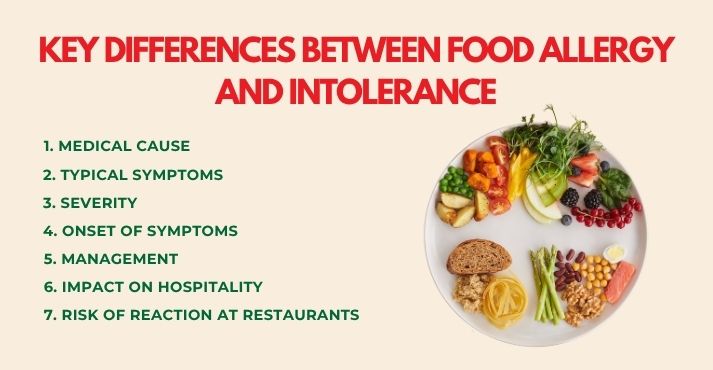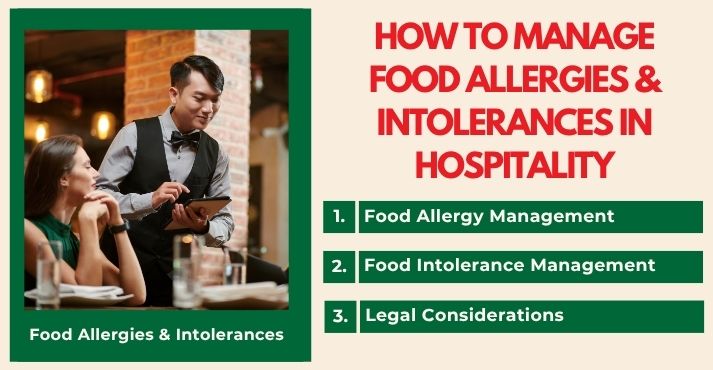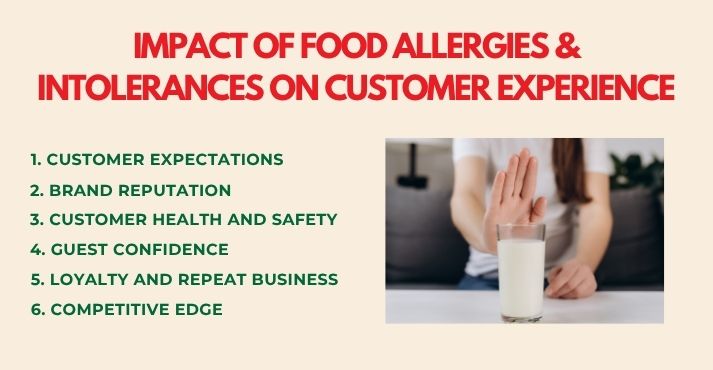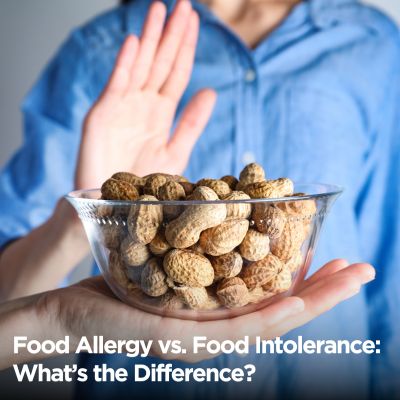Confusing a food allergy vs. food intolerance is more common than most people realize. Both can cause uncomfortable and sometimes alarming symptoms, such as bloating, stomach cramps, nausea, or skin rashes.
However, the causes behind these reactions are entirely different, and so are the methods for diagnosing and treating them.
A food allergy occurs when the immune system mistakenly identifies a food protein as harmful, triggering a defensive response ranging from mild symptoms to life-threatening anaphylaxis.
Food intolerance typically results from the digestive system’s inability to break down certain foods properly. This may lead to discomfort but is not considered life-threatening.
Because symptoms can overlap, many people assume they have one condition when they actually have another. This can lead to ineffective treatment or unnecessary dietary restrictions.
Learning the difference between food allergy and food intolerance is essential for making informed health choices, seeking medical guidance, and improving overall well-being.
What is a Food Allergy?
A food allergy is a serious medical condition in which the immune system mistakenly identifies a specific food protein as a threat. In response, the body produces immunoglobulin E (IgE) antibodies, which trigger the release of chemicals like histamine.
This immune reaction can happen within minutes of eating the offending food, ranging from mild to life-threatening.
The most common food allergens include peanuts, tree nuts, shellfish, fish, milk, eggs, soy, and wheat. Even trace amounts can provoke a reaction in individuals with these allergies.
Symptoms may include hives, itching, facial swelling, abdominal pain, vomiting, difficulty breathing, or, in severe cases, anaphylaxis, which is a potentially fatal reaction that requires immediate medical attention.
Nearly 11% of adults aged 18 and above suffer from at least one food allergy. Because of this, people with food allergies must avoid known allergens, carefully check food labels, and carry emergency medication, such as an epinephrine auto-injector (EpiPen).
What is Food Intolerance?
Food intolerance is a digestive condition that occurs when the body struggles to break down certain foods, often due to enzyme deficiencies or sensitivities.
Unlike food allergies, food intolerances do not involve the immune system. Instead, they primarily cause digestive symptoms such as bloating, gas, diarrhea, and abdominal pain.
Common examples include lactose intolerance, which is the inability to digest lactose, a sugar found in milk, and gluten intolerance, a sensitivity to gluten, a protein found in wheat and other grains.
Symptoms often include nausea, stomach cramps, and bloating, but these reactions are generally less severe than those caused by food allergies.
It is estimated that food intolerances affect up to 20% of the population, making these conditions quite common.
Managing food intolerances in daily life usually involves adjusting one’s diet to avoid certain trigger foods or using enzyme supplements such as lactase to help digest lactose.
The food and beverage industry recognizes these challenges and offers more options that cater to people with intolerances, helping them enjoy meals without discomfort.
Key Differences Between Food Allergy and Intolerance

Food allergies and food intolerances often share similar symptoms but differ significantly in their causes and management.
This knowledge is crucial for personal health and is particularly relevant in industries such as hospitality, where proper food handling and communication can prevent severe reactions.
| Aspect | Food Allergy | Food Intolerance |
|---|---|---|
| Medical Cause | Immune system reaction to food protein (IgE-mediated) | Digestive system issue, often enzyme deficiency or sensitivity |
| Typical Symptoms | Hives, swelling, difficulty breathing, anaphylaxis | Bloating, gas, diarrhea, abdominal pain |
| Severity | Can be life-threatening | Usually less severe, mostly digestive discomfort |
| Onset of Symptoms | Within minutes to 2 hours | Often delayed, can take hours to appear |
| Management | Strict avoidance, carry epinephrine (EpiPen) | Diet modification, enzyme supplements (e.g., lactase) |
| Impact on Hospitality | Requires clear allergen labeling, staff training, and strict cross-contamination prevention | Needs clear ingredient information and options for modified dishes |
| Risk of Reaction at Restaurants | High if allergens are present or cross-contact occurs | Lower risk but can cause discomfort if trigger foods are consumed |
How to Manage Food Allergies and Intolerances in Hospitality

Proper management of food allergies and intolerances is crucial in the hospitality industry to ensure guest safety and satisfaction.
Restaurants, hotels, and catering services must implement effective practices to minimize risks and enhance the overall guest experience. Clear communication and staff training are important for managing these dietary concerns effectively.
1. Food Allergy Management
Restaurants and hotels must be fully prepared to handle food allergies by offering menus that list common allergens. Kitchen staff should be trained to communicate openly with guests, asking about allergies before taking orders.
This helps prevent accidental exposure to allergens, which can cause severe symptoms of food allergies or intolerances, including potentially life-threatening reactions.
Establishing allergen-free zones or dedicated meal preparation areas reduces the risk of cross-contamination, especially when preparing hors d’oeuvres and appetizers with multiple ingredients.
Staff must also be trained to inform guests immediately if any ingredient substitutions or changes occur, ensuring transparency and trust.
For example, in 2022, Dominic Jones, co-owner and CEO of JP Restaurants, took major steps to reform allergen practices after his daughter suffered an anaphylactic reaction to a vegan ice cream that contained undisclosed cashew butter.
This serious incident led Jones to overhaul allergen management across all eight restaurants. Measures included introducing an allergen scoring system, removing high-risk ingredients, and pushing for legislation similar to the UK’s “Natasha’s Law” to mandate clearer food labeling.
2. Food Intolerance Management
Food intolerances are generally less severe than allergies, but they still require careful handling to prevent discomfort for guests. Asking specific questions during the ordering process helps identify intolerances and allows staff to recommend suitable alternatives.
Hotels and catering services should offer options such as gluten-free, lactose-free, or low-FODMAP dishes to accommodate a variety of intolerances.
Providing detailed ingredient information enables guests to make informed choices, enhancing their overall dining experience while minimizing the risk of digestive symptoms.
3. Legal Considerations
Compliance with food safety regulations is crucial for all hospitality businesses. Accurate labeling of allergens and dietary information on menus helps prevent legal issues and protects guests from potential health risks.
It also ensures that establishments meet standards set by health authorities regarding the accommodation of dietary restrictions.
Regular staff training on legal responsibilities and updated protocols helps maintain a safe environment for all guests, reinforcing the establishment’s commitment to the well-being and satisfaction of its guests.
Impact of Food Allergies and Intolerances on Customer Experience

Food allergies and intolerances directly impact how guests interact with restaurants and hotels. From the moment they consider dining out to the final check, their experience depends on how well their dietary needs are recognized and accommodated.
For hospitality providers, meeting these needs is essential to improving safety, loyalty, and satisfaction throughout the guest journey.
1. Customer Expectations
Diners these days, especially those with dietary restrictions, expect more than just allergen-free food. They seek personalized service, transparent communication, and meticulous attention to detail.
Customers with food allergies and intolerances want to feel confident that their needs will be easily met.
This includes staff proactively asking about allergies during the ordering process, knowing how to identify food allergies and intolerances, and providing clear alternatives such as dairy-free gelato and ice cream or gluten-free bread.
Meeting these expectations not only prevents issues but also builds trust. When guests feel seen and heard, they’re far more likely to return and speak positively about their experience.
2. Brand Reputation
How a restaurant or hotel manages food allergies and intolerances can directly influence its reputation. Guests remember both positive and negative experiences, and in today’s review-driven culture, word spreads quickly.
Mishandling a food allergy, even unintentionally, can lead to serious consequences, from health risks to public backlash.
On the other hand, businesses that consistently offer safe, accommodating experiences often earn praise, especially from families and individuals who rely on reliable service.
A full-service restaurant known for its allergen-aware practices can quickly become a preferred destination for cautious diners and their networks.
3. Customer Health and Safety
The impact of food allergies on health is substantial, especially when considering severe reactions like anaphylaxis.
A mistake, such as cross-contact in the kitchen or a mislabeled menu item, can endanger lives. That’s why clear protocols, ongoing staff training, and communication are essential.
Providing a safe dining environment is not just about compliance, but also about protecting lives. Guests who feel safe are more likely to stay longer, spend more, and spread the word to others seeking peace of mind.
4. Guest Confidence
Dining out with a food allergy or intolerance can be stressful. Many guests face uncertainty every time they look at a menu or place an order.
Hospitality businesses can turn that anxiety into comfort by proactively addressing these concerns through clear labeling, trained staff, and flexible substitutions.
When guests feel confident that a venue understands and respects their needs, it significantly enhances their experience.
Offering clear distinctions, like whether a dessert is gelato or ice cream with dairy, can mean the difference between trust and hesitation. This sense of being valued often leads to higher satisfaction and positive reviews.
5. Loyalty and Repeat Business
Loyalty often stems from consistent, thoughtful service. For guests with allergies or intolerances, that consistency is even more meaningful. When these guests feel their dietary needs are genuinely respected, they are far more likely to return.
In fact, surveys reveal that 36% of people with food allergies consider themselves very loyal, often returning to the same venues where they feel safe and accommodated.
Moreover, businesses that effectively accommodate guests with allergies can see a 24% increase in profit margins due to increased return visits and word-of-mouth referrals.
This level of trust also encourages group dining and family visits, expanding the customer base beyond just one individual’s repeat business.
6. Competitive Edge
Catering to guests with food allergies and intolerances can set a business apart. In areas with high dietary awareness, offering inclusive options and excellent communication becomes a powerful differentiator.
Guests are more likely to choose venues they know will accommodate them without friction. For example, restaurants that train staff to ask questions, adjust meals accordingly, and provide clearly labeled menus often stand out as reliable and forward-thinking establishments.
This reputation for attentiveness can lead to stronger customer retention and help attract new diners actively searching for safe and enjoyable dining experiences.
Conclusion
Food allergies and food intolerances differ significantly in their causes, symptoms, and management, but both require careful attention within the hospitality industry.
Recognizing these differences is essential for restaurants, hotels, and catering services to provide safe and enjoyable dining experiences.
Being well-prepared to handle food allergy and intolerance cases helps protect customer health while enhancing satisfaction and trust.
Hospitality businesses that invest in thorough staff training, clear communication, and strict compliance with food safety regulations demonstrate their commitment to guest well-being. This not only reduces risks but also strengthens brand reputation and loyalty.
Effectively managing food allergy and intolerance in restaurants is more than a regulatory necessity; it is vital to delivering excellent guest service.













